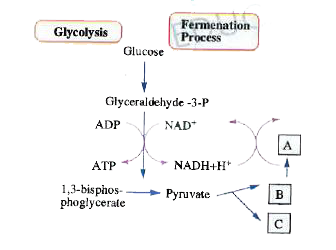Depict an outline of pathways of anaerobic respiration.
Step-by-Step Solution for Pathways of Anaerobic Respiration
1. Start with Glucose: The process of anaerobic respiration begins with glucose, which is a simple sugar and the primary energy source for cells.
2. Conversion to Glyceraldehyde 3-Phosphate: Glucose is converted into glyceraldehyde 3-phosphate (G3P) through a series of enzymatic reactions. This step involves the investment of energy in the form of ATP.
3. Formation of 3-Phosphoglyceric Acid: G3P is then converted into 3-phosphoglyceric acid (3-PGA). This conversion is facilitated by the enzyme phosphoglycerate kinase.
4. Conversion to Phosphoenolpyruvic Acid: The 3-PGA is further transformed into phosphoenolpyruvic acid (PEP). This is an important step as PEP is a high-energy compound.
5. Formation of Pyruvic Acid: PEP is then converted into pyruvic acid (pyruvate) through the action of the enzyme pyruvate kinase. This step also generates ATP.
6. Anaerobic Pathways: Depending on the organism and conditions, pyruvic acid can follow two main pathways:
- Lactic Acid Fermentation: In some organisms (like muscle cells in animals), pyruvic acid is converted into lactic acid. This process regenerates NAD+ from NADH, allowing glycolysis to continue.
- Alcoholic Fermentation: In other organisms (like yeast), pyruvic acid is converted into ethanol and carbon dioxide (CO2). This process also regenerates NAD+ from NADH.
Summary of Anaerobic Respiration Pathways:
- Glucose → Glyceraldehyde 3-Phosphate → 3-Phosphoglyceric Acid → Phosphoenolpyruvic Acid → Pyruvic Acid
- Pyruvic Acid → Lactic Acid (in animals) or Ethanol + CO2 (in yeast)
- Lactic Acid Fermentation: In some organisms (like muscle cells in animals), pyruvic acid is converted into lactic acid. This process regenerates NAD+ from NADH, allowing glycolysis to continue.
- Alcoholic Fermentation: In other organisms (like yeast), pyruvic acid is converted into ethanol and carbon dioxide (CO2). This process also regenerates NAD+ from NADH.
- Glucose → Glyceraldehyde 3-Phosphate → 3-Phosphoglyceric Acid → Phosphoenolpyruvic Acid → Pyruvic Acid
- Pyruvic Acid → Lactic Acid (in animals) or Ethanol + CO2 (in yeast)
Topper's Solved these Questions
- CELLULAR RESPIRATION IN PLANTS BOOK - ICSECHAPTER - CELLULAR RESPIRATION IN PLANTS EXERCISE - REVIEW QUESTIONS ( SHORT ANSWER TYPE QUESTIONS)
22 Videos
- CELL CYCLE AND CELL DIVISION BOOK - ICSECHAPTER - CELL CYCLE AND CELL DIVISION EXERCISE - REVIEW QUESTIONS ( LOOK AT THE FIGURE BELOW)
2 Videos
- CHEMICAL CO-ORDINATION AND INTEGRATIONBOOK - ICSECHAPTER - CHEMICAL CO-ORDINATION AND INTEGRATIONEXERCISE - NCERT EXERCISES WITH ANSWERS (DIFFERENTIATE BETWEEN)
11 Videos
Similar Questions
Knowledge Check
What does A,B and C depict in the given pathways of anaerobic respiration ?
 AABCNADH+H+→NAD+NAD+→NADH+H+NAD+→NADH+H+BABCNADH+H+→NAD+NADH+H+→NAD+NAD+→NADH+H+CABCNAD+→NADH+H+NADH+H+→NAD+NADH+H+→NAD+DABCNAD+→NADH+H+NADH+H+→NAD+NAD+→NADH+H+
AABCNADH+H+→NAD+NAD+→NADH+H+NAD+→NADH+H+BABCNADH+H+→NAD+NADH+H+→NAD+NAD+→NADH+H+CABCNAD+→NADH+H+NADH+H+→NAD+NADH+H+→NAD+DABCNAD+→NADH+H+NADH+H+→NAD+NAD+→NADH+H+RQ in anaerobic respiration is
A0.7B0.9CunityDinfinity
Give a summary of various pathways of anaerobic respiration.
View SolutionChoose the correct combination of labelling the molecules involved in the pathway of anaerobic respiration in yeast.

View SolutionChoose the correct combination of labelling the molecules involved in the pathway of anaerobic respiration in Yeast

View SolutionEnd product of anaerobic respiration is
View SolutionExplain the common metabolic pathway of aerobic and anaerobic respiration.
View SolutionWhat is common in common pathway of aerobic respiration
View Solution
